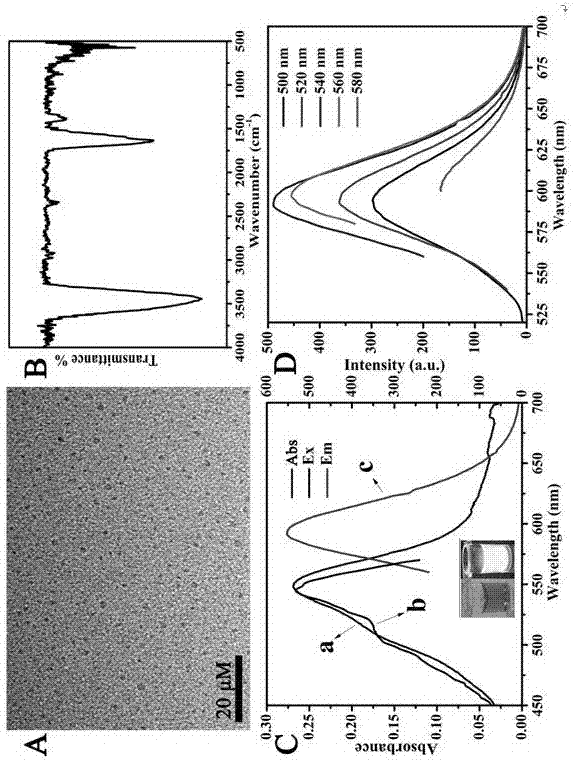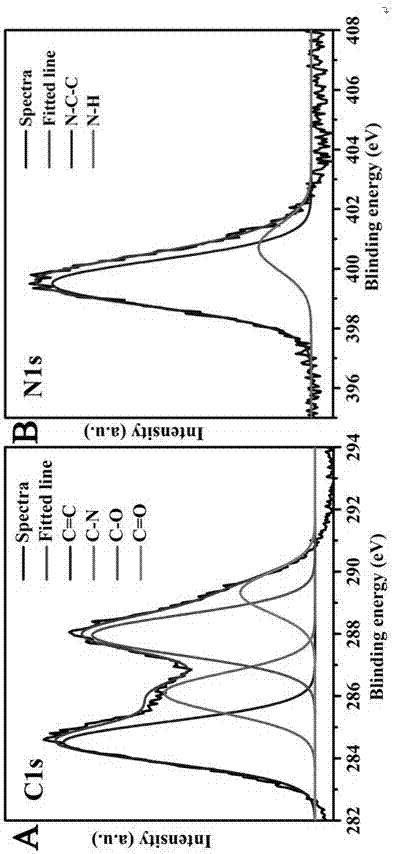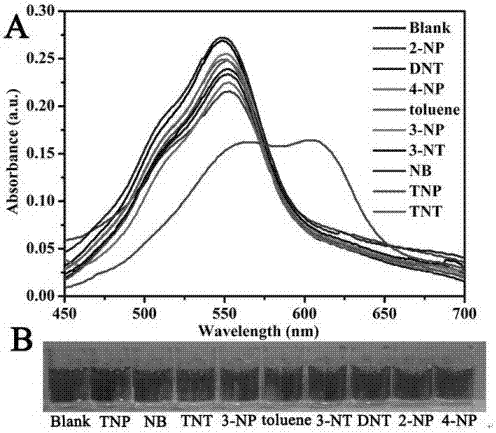Fluorescent carbon quantum dot and application
A carbon quantum dot and fluorescence technology, which is applied to fluorescent carbon quantum dots and its application in the detection of TNP and intracellular imaging, can solve the problems of large size of nanomaterials, low safety factor, and toxic applications, and achieves low cost, Easy operation, high sensitivity and selective effect
- Summary
- Abstract
- Description
- Claims
- Application Information
AI Technical Summary
Problems solved by technology
Method used
Image
Examples
Embodiment 1
[0023] Example 1 Preparation and Characterization of Fluorescent Carbon Quantum Dots
[0024] Put 1g of citric acid and 2g of urea into a stainless steel reaction kettle, and then add 10mL of dimethylformamide to it. After the reaction kettle is closed, the mixture is heated to 160°C. After the reaction is carried out for about 6 hours, the obtained brown solution is Cool to room temperature, add 20mL NaOH (50mg / mL), mix and stir for 1min, centrifuge at about 16000rpm for about 10min, collect the precipitate, dissolve it in water and continue centrifuging (16000r / min, 10min), repeat washing twice , remove residual salt, alkali and other substances, and freeze-dry the precipitate to obtain black solid powder, that is, carbon quantum dots.
[0025] The morphology was characterized by transmission electron microscopy (e.g. figure 1 As shown in A), the carbon quantum dots in the transmission electron microscope picture are small in size and evenly distributed. (Such as figure 1...
Embodiment 2
[0027] Example 2 Fluorescent carbon quantum dots detect TNP
[0028] (1) Optional
[0029] Colorimetric detection: Nine nitroaromatic compounds were detected under the same conditions, including: toluene (toluene), nitrobenzene (NB), m-nitrotoluene (3-NT), 2,4,6- Trinitrophenol (TNP), o-nitrophenol (2-NP), m-nitrophenol (3-NP), 2,4-dinitrotoluene (DNT), 2,4,6-trinitrotoluene (TNT) and p-nitrophenol (4-NP). (Such as image 3A) shows that the ultraviolet absorption spectrum of the carbon quantum dot solution has an absorption peak at 548nm. After adding TNP, the carbon quantum dot absorption peak red shifts and a second absorption peak appears at 605nm. However, the UV absorption peaks did not change significantly after adding the same amount of other nitroaromatic compounds to the solution. (Such as image 3 In B), it can be seen that after adding TNP, the carbon quantum dot solution changed from the original pink to blue within a few seconds, while the solution mixed with...
Embodiment 3
[0034] Example 3 Cell fluorescence imaging experiment
[0035] Culture of Hela cells, a type of cell used in biological and medical research. Then use the thiazolium blue colorimetric method (MTT method) to test the toxicity of carbon quantum dots (such as Figure 6 ). It can be observed that different concentrations (0, 10, 20, 40, 50 μg / mL) of carbon quantum dots were cultured with Hela cells for 24 hours. After the culture was completed, the viability of Hela cells was tested, and the viability of the cells was strong. It shows that carbon quantum dots have low toxicity to cells. Compared with other biological probes, carbon quantum dots have good cell compatibility.
[0036] Carbon quantum dots have the characteristics of strong orange fluorescence, small particle size, high stability, good compatibility, and low toxicity, so try to apply carbon quantum dot solutions to cell imaging experiments. After the carbon quantum dots were cultured with Hela cells for 3 hours, th...
PUM
 Login to View More
Login to View More Abstract
Description
Claims
Application Information
 Login to View More
Login to View More - R&D
- Intellectual Property
- Life Sciences
- Materials
- Tech Scout
- Unparalleled Data Quality
- Higher Quality Content
- 60% Fewer Hallucinations
Browse by: Latest US Patents, China's latest patents, Technical Efficacy Thesaurus, Application Domain, Technology Topic, Popular Technical Reports.
© 2025 PatSnap. All rights reserved.Legal|Privacy policy|Modern Slavery Act Transparency Statement|Sitemap|About US| Contact US: help@patsnap.com



